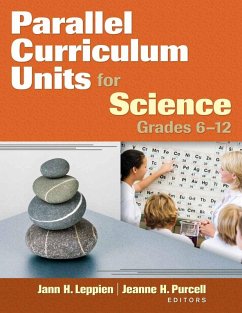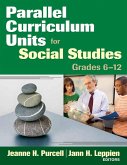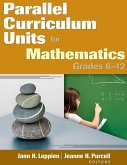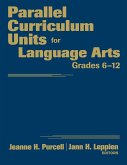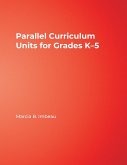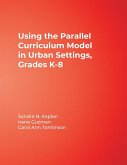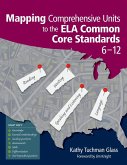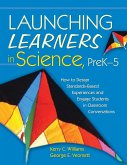- Broschiertes Buch
- Merkliste
- Auf die Merkliste
- Bewerten Bewerten
- Teilen
- Produkt teilen
- Produkterinnerung
- Produkterinnerung
Breathe new life into science learning with this powerful guidebook that shows how to create more thoughtful curriculum and differentiate lessons to benefit all students.
Andere Kunden interessierten sich auch für
![Parallel Curriculum Units for Social Studies, Grades 6-12 Parallel Curriculum Units for Social Studies, Grades 6-12]() Jeanne H. PurcellParallel Curriculum Units for Social Studies, Grades 6-1243,99 €
Jeanne H. PurcellParallel Curriculum Units for Social Studies, Grades 6-1243,99 €![Parallel Curriculum Units for Mathematics, Grades 6-12 Parallel Curriculum Units for Mathematics, Grades 6-12]() Jann H. LeppienParallel Curriculum Units for Mathematics, Grades 6-1233,99 €
Jann H. LeppienParallel Curriculum Units for Mathematics, Grades 6-1233,99 €![Parallel Curriculum Units for Language Arts, Grades 6-12 Parallel Curriculum Units for Language Arts, Grades 6-12]() Jeanne H. PurcellParallel Curriculum Units for Language Arts, Grades 6-1243,99 €
Jeanne H. PurcellParallel Curriculum Units for Language Arts, Grades 6-1243,99 €![Parallel Curriculum Units for Grades K-5 Parallel Curriculum Units for Grades K-5]() Marcia B. ImbeauParallel Curriculum Units for Grades K-546,99 €
Marcia B. ImbeauParallel Curriculum Units for Grades K-546,99 €![Using the Parallel Curriculum Model in Urban Settings, Grades K-8 Using the Parallel Curriculum Model in Urban Settings, Grades K-8]() Sandra N. KaplanUsing the Parallel Curriculum Model in Urban Settings, Grades K-846,99 €
Sandra N. KaplanUsing the Parallel Curriculum Model in Urban Settings, Grades K-846,99 €![Mapping Comprehensive Units to the ELA Common Core Standards, 6-12 Mapping Comprehensive Units to the ELA Common Core Standards, 6-12]() Kathy Tuchman GlassMapping Comprehensive Units to the ELA Common Core Standards, 6-1243,99 €
Kathy Tuchman GlassMapping Comprehensive Units to the ELA Common Core Standards, 6-1243,99 €![Launching Learners in Science, PreK-5 Launching Learners in Science, PreK-5]() Kerry C. WilliamsLaunching Learners in Science, PreK-542,99 €
Kerry C. WilliamsLaunching Learners in Science, PreK-542,99 €-
-
-
Breathe new life into science learning with this powerful guidebook that shows how to create more thoughtful curriculum and differentiate lessons to benefit all students.
Hinweis: Dieser Artikel kann nur an eine deutsche Lieferadresse ausgeliefert werden.
Hinweis: Dieser Artikel kann nur an eine deutsche Lieferadresse ausgeliefert werden.
Produktdetails
- Produktdetails
- Verlag: Corwin
- Seitenzahl: 242
- Erscheinungstermin: 15. Februar 2011
- Englisch
- Abmessung: 280mm x 216mm x 13mm
- Gewicht: 620g
- ISBN-13: 9781412965422
- ISBN-10: 141296542X
- Artikelnr.: 31556371
- Herstellerkennzeichnung
- Libri GmbH
- Europaallee 1
- 36244 Bad Hersfeld
- gpsr@libri.de
- Verlag: Corwin
- Seitenzahl: 242
- Erscheinungstermin: 15. Februar 2011
- Englisch
- Abmessung: 280mm x 216mm x 13mm
- Gewicht: 620g
- ISBN-13: 9781412965422
- ISBN-10: 141296542X
- Artikelnr.: 31556371
- Herstellerkennzeichnung
- Libri GmbH
- Europaallee 1
- 36244 Bad Hersfeld
- gpsr@libri.de
Jann Leppien served as a gifted and talented coordinator in Montana prior to attending the University of Connecticut, where she earned her doctorate in gifted education and worked as a research assistant at the National Research Center for the Gifted and Talented. She has been a teacher for 24 years, spending 14 of those years working as a classroom teacher, enrichment specialist, and coordinator of the Schoolwide Enrichment Model in Montana. She is past president of the Montana Association for Gifted and Tal-ented Education. Currently, she is an associate professor in the School of Education at the University of Great Falls in Montana. Leppien teaches graduate and under-graduate courses in gifted education, educational research, curriculum and assess-ment, creativity, and methods courses in math, science, and social studies. Her research interests include teacher collaboration, curriculum design, underachievement, and planning instruction for advanced learners. Leppien works as a consultant to teachers in the field of gifted education and as a national trainer for the Talents Unlimited Program. She is coauthor of The Multiple Menu Model: A Par-allel Guide for Developing Differentiated Curriculum. She is active in the National Association for Gifted Children (NAGC), serving as a board member and newsletter editor of the Curriculum Division, and a board member of the Association for the Education of Gifted Underachieving Students. Jeanne H. Purcell is the consultant to the Connecticut State Depart-ment of Education for gifted and talented education. She is also director of UConn Mentor Connection, a nationally recognized summer mentorship program for talented teenagers that is part of the NEAG Center for Talent Development at the University of Con-necticut. Prior to her work at the State Department of Connecticut, she was an administrator for Rocky Hill Public Schools (CT); a pro-gram specialist with the National Research Center on the Gifted and Talented, where she worked collaboratively with other researchers on national issues related to high-achieving young people; an instructor of Teaching the Talented, a graduate-level program in gifted education; and a staff developer to school districts across the country and Canada. She has been an En-glish teacher, community service coordinator, and teacher of the gifted, K-12, for 18 years in Connecticut school districts and has published many articles that have appeared in Educational Leadership, Gifted Child Quarterly, Roeper Review, Educa-tional and Psychological Measurement, National Association of Secondary School Principals' Bulletin, Our Children: The National PTA Magazine, Parenting for High Potential, and Journal for the Education of the Gifted. She is active in the National Association for Gifted Children (NAGC) and serves on the Awards Committee and the Curriculum Committee of NAGC, for which she is the co-chair for the annual Curriculum Awards Competition.
About the Editors
About the Contributors
Introduction
1. Genetics: Our Past, Present, and Future: A Middle School Unit for Grades
6-8 - Lindsey Asbury
Introduction to the Unit
Background to the Unit
Content Framework
Unit Components and Rationale
Unit Sequence, Description, and Teacher Reflection
Lesson 1.1: Preassessment and Unit Introduction (Dominant and Recessive
Genes)
Lesson 1.2: Punnet Squares and Predicting Heredity
Lesson 1.3: DNA
Lesson 1.4: DNA Extraction Lab
Lesson 1.5: DNA Fingerprinting and Crime Lab Investigation
Lesson 1.6: Genetics and European History
Lesson 1.7: Genetics in Practice
Unit 1 Appendixes
2. The Exxon Valdez Oil Spill: What¿s at Stake? The Convergence of Science
and Society, Grade 6 - Julie Martinek
Introduction to the Unit
Background to the Unit
Content Framework
Unit Assessments
Unit Sequence, Description, and Teacher Reflection
Lesson 2.1: Pretest: The Cause-and-Effect Relationship within a System
Lesson 2.2: Introduction to the Exxon Valdez Problem
Lesson 2.3: Setting Up the Stakeholders? Research Activities
Lesson 2.4: Prioritizing the Sites and Constructing a Persuasive
Argument/Essay
Unit 2 Appendixes
3. Systems: An Integrated Approach to Science and English Instruction,
Grades 9-10 - Kristina J. Doubet
Introduction to the Unit
Background to the Unit
Content Framework
Lesson/Unit Assessments
Lesson Sequence and Teacher Reflection
Lesson3.1: An Introduction to Systems
Lesson 3.2 (English): The Pearl, Part 1 (Chapters 1-3)
Lesson 3.3 (Science): Introducing Cell Structure
Lesson 3.4 (English): The Pearl, Part 2 (Chapters 4-6)
Lesson 3.5 (Science): Movement in Cells
Unit 3 Appendixes
4. The Periodic Table: Getting to Know and Appreciate the Elements and
Their Families, Grade 10 - Fie Budzinsky
Background to the Unit
Content Framework
Overview of Key Lesson Ideas/Purposes
Lesson 4.1: The Elements: Getting to Know You
Lesson 4.2: The Elements: Up Close and Personal
Lesson 4.3: We Are Family!
Lesson 4.4: The Elements in Action
Lesson 4.5: Breaking News
Unit 4 Appendixes
About the Contributors
Introduction
1. Genetics: Our Past, Present, and Future: A Middle School Unit for Grades
6-8 - Lindsey Asbury
Introduction to the Unit
Background to the Unit
Content Framework
Unit Components and Rationale
Unit Sequence, Description, and Teacher Reflection
Lesson 1.1: Preassessment and Unit Introduction (Dominant and Recessive
Genes)
Lesson 1.2: Punnet Squares and Predicting Heredity
Lesson 1.3: DNA
Lesson 1.4: DNA Extraction Lab
Lesson 1.5: DNA Fingerprinting and Crime Lab Investigation
Lesson 1.6: Genetics and European History
Lesson 1.7: Genetics in Practice
Unit 1 Appendixes
2. The Exxon Valdez Oil Spill: What¿s at Stake? The Convergence of Science
and Society, Grade 6 - Julie Martinek
Introduction to the Unit
Background to the Unit
Content Framework
Unit Assessments
Unit Sequence, Description, and Teacher Reflection
Lesson 2.1: Pretest: The Cause-and-Effect Relationship within a System
Lesson 2.2: Introduction to the Exxon Valdez Problem
Lesson 2.3: Setting Up the Stakeholders? Research Activities
Lesson 2.4: Prioritizing the Sites and Constructing a Persuasive
Argument/Essay
Unit 2 Appendixes
3. Systems: An Integrated Approach to Science and English Instruction,
Grades 9-10 - Kristina J. Doubet
Introduction to the Unit
Background to the Unit
Content Framework
Lesson/Unit Assessments
Lesson Sequence and Teacher Reflection
Lesson3.1: An Introduction to Systems
Lesson 3.2 (English): The Pearl, Part 1 (Chapters 1-3)
Lesson 3.3 (Science): Introducing Cell Structure
Lesson 3.4 (English): The Pearl, Part 2 (Chapters 4-6)
Lesson 3.5 (Science): Movement in Cells
Unit 3 Appendixes
4. The Periodic Table: Getting to Know and Appreciate the Elements and
Their Families, Grade 10 - Fie Budzinsky
Background to the Unit
Content Framework
Overview of Key Lesson Ideas/Purposes
Lesson 4.1: The Elements: Getting to Know You
Lesson 4.2: The Elements: Up Close and Personal
Lesson 4.3: We Are Family!
Lesson 4.4: The Elements in Action
Lesson 4.5: Breaking News
Unit 4 Appendixes
About the Editors
About the Contributors
Introduction
1. Genetics: Our Past, Present, and Future: A Middle School Unit for Grades
6-8 - Lindsey Asbury
Introduction to the Unit
Background to the Unit
Content Framework
Unit Components and Rationale
Unit Sequence, Description, and Teacher Reflection
Lesson 1.1: Preassessment and Unit Introduction (Dominant and Recessive
Genes)
Lesson 1.2: Punnet Squares and Predicting Heredity
Lesson 1.3: DNA
Lesson 1.4: DNA Extraction Lab
Lesson 1.5: DNA Fingerprinting and Crime Lab Investigation
Lesson 1.6: Genetics and European History
Lesson 1.7: Genetics in Practice
Unit 1 Appendixes
2. The Exxon Valdez Oil Spill: What¿s at Stake? The Convergence of Science
and Society, Grade 6 - Julie Martinek
Introduction to the Unit
Background to the Unit
Content Framework
Unit Assessments
Unit Sequence, Description, and Teacher Reflection
Lesson 2.1: Pretest: The Cause-and-Effect Relationship within a System
Lesson 2.2: Introduction to the Exxon Valdez Problem
Lesson 2.3: Setting Up the Stakeholders? Research Activities
Lesson 2.4: Prioritizing the Sites and Constructing a Persuasive
Argument/Essay
Unit 2 Appendixes
3. Systems: An Integrated Approach to Science and English Instruction,
Grades 9-10 - Kristina J. Doubet
Introduction to the Unit
Background to the Unit
Content Framework
Lesson/Unit Assessments
Lesson Sequence and Teacher Reflection
Lesson3.1: An Introduction to Systems
Lesson 3.2 (English): The Pearl, Part 1 (Chapters 1-3)
Lesson 3.3 (Science): Introducing Cell Structure
Lesson 3.4 (English): The Pearl, Part 2 (Chapters 4-6)
Lesson 3.5 (Science): Movement in Cells
Unit 3 Appendixes
4. The Periodic Table: Getting to Know and Appreciate the Elements and
Their Families, Grade 10 - Fie Budzinsky
Background to the Unit
Content Framework
Overview of Key Lesson Ideas/Purposes
Lesson 4.1: The Elements: Getting to Know You
Lesson 4.2: The Elements: Up Close and Personal
Lesson 4.3: We Are Family!
Lesson 4.4: The Elements in Action
Lesson 4.5: Breaking News
Unit 4 Appendixes
About the Contributors
Introduction
1. Genetics: Our Past, Present, and Future: A Middle School Unit for Grades
6-8 - Lindsey Asbury
Introduction to the Unit
Background to the Unit
Content Framework
Unit Components and Rationale
Unit Sequence, Description, and Teacher Reflection
Lesson 1.1: Preassessment and Unit Introduction (Dominant and Recessive
Genes)
Lesson 1.2: Punnet Squares and Predicting Heredity
Lesson 1.3: DNA
Lesson 1.4: DNA Extraction Lab
Lesson 1.5: DNA Fingerprinting and Crime Lab Investigation
Lesson 1.6: Genetics and European History
Lesson 1.7: Genetics in Practice
Unit 1 Appendixes
2. The Exxon Valdez Oil Spill: What¿s at Stake? The Convergence of Science
and Society, Grade 6 - Julie Martinek
Introduction to the Unit
Background to the Unit
Content Framework
Unit Assessments
Unit Sequence, Description, and Teacher Reflection
Lesson 2.1: Pretest: The Cause-and-Effect Relationship within a System
Lesson 2.2: Introduction to the Exxon Valdez Problem
Lesson 2.3: Setting Up the Stakeholders? Research Activities
Lesson 2.4: Prioritizing the Sites and Constructing a Persuasive
Argument/Essay
Unit 2 Appendixes
3. Systems: An Integrated Approach to Science and English Instruction,
Grades 9-10 - Kristina J. Doubet
Introduction to the Unit
Background to the Unit
Content Framework
Lesson/Unit Assessments
Lesson Sequence and Teacher Reflection
Lesson3.1: An Introduction to Systems
Lesson 3.2 (English): The Pearl, Part 1 (Chapters 1-3)
Lesson 3.3 (Science): Introducing Cell Structure
Lesson 3.4 (English): The Pearl, Part 2 (Chapters 4-6)
Lesson 3.5 (Science): Movement in Cells
Unit 3 Appendixes
4. The Periodic Table: Getting to Know and Appreciate the Elements and
Their Families, Grade 10 - Fie Budzinsky
Background to the Unit
Content Framework
Overview of Key Lesson Ideas/Purposes
Lesson 4.1: The Elements: Getting to Know You
Lesson 4.2: The Elements: Up Close and Personal
Lesson 4.3: We Are Family!
Lesson 4.4: The Elements in Action
Lesson 4.5: Breaking News
Unit 4 Appendixes

